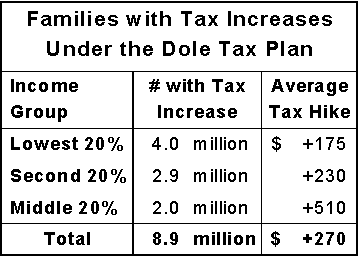August 26, 1996 12:47 PM | Permalink | ![]()
For Immediate Release,
Monday, August 26, 1996
Citizens for Tax Justice today released final estimates of the cost and distribution of GOP presidential candidate Bob Dole’s 1996 campaign tax plan. The analysis finds that the Dole plan would add $132 billion a year to the federal budget deficit when fully phased in (in 1996 dollars). By comparison, the deficit for fiscal 1996 is estimated to be about $120 billion.

- CTJ’s analysis also found that:
- The richest one percent of all families would save an average of $29,000 a year in taxes under the Dole plan (and would get 27% of the total tax cuts).
- In contrast, the typical taxpayer would get a tax reduction of only $330. That’s far less than the reductions in federal programs necessary to offset the cost of the tax-cut plan, which would average about $1,100 per family.
- 8.9 million low- and moderate-income working families would face tax increases averaging $270 each under the Dole plan, due to its proposed reductions in the earned-income tax credit.
- Three-quarters of the proposed Dole tax cuts would go to the best-off 20% of all families.
- The bottom three-fifths of all families would get less than 7% of Dole’s total proposed tax cuts.
CTJ analyzed the Dole plan using the Institute on Taxation & Economic Policy’s Microsimulation Tax Model. The ITEP model is similar in scope and methodology to computer tax models used by the congressional Joint Committee on Taxation and the U.S. Treasury Department. For purposes of the analysis, the term “families” encompasses all taxpaying units, including married couples, single parents and individuals.
CTJ’s analysis includes: Dole’s proposed 15% across-the-board reduction in personal income tax rates, his proposed capital gains tax reduction (to a maximum rate of 14%), his proposed reduction in taxation of Social Security benefits at higher income levels (back to pre-1993 rules), his proposed expansion of Individual Retirement Accounts (including education accounts), his proposed reductions in the earned-income tax credit for low- and moderate-income working families (patterned after the congressional proposal vetoed last year) and Dole’s proposed $500-per-child credit. The last item is phased out between $75,000 and $110,000 in adjusted gross income, and according to the Dole campaign will generally be unavailable to low- and moderate-income working families receiving the earned-income tax credit (contrary to a previous Dole campaign assertion that the credit would be for “low- and middle-income families”).
at higher income levels (back to pre-1993 rules), his proposed expansion of Individual Retirement Accounts (including education accounts), his proposed reductions in the earned-income tax credit for low- and moderate-income working families (patterned after the congressional proposal vetoed last year) and Dole’s proposed $500-per-child credit. The last item is phased out between $75,000 and $110,000 in adjusted gross income, and according to the Dole campaign will generally be unavailable to low- and moderate-income working families receiving the earned-income tax credit (contrary to a previous Dole campaign assertion that the credit would be for “low- and middle-income families”).
CTJ’s final estimates of the cost and distribution of the Dole plan is slightly different from preliminary estimates released on August 5 because of subsequent revelations by the Dole campaign about the earned-income tax credit reductions and limits on the per-child credit.
CTJ’s estimated cost of the Dole plan does not include a $25-40 billion a year spending proposal that would allow taxpayers to designate that up to $250 of their taxes ($500 for couples) be sent to a qualifying charitable organization or organizations. The Dole campaign has not included the cost of this spending proposal in its budget figures.



